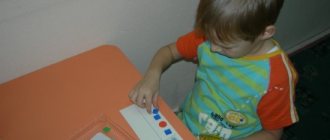In children, speech skills develop gradually until approximately 4 years of age. Some errors in speech are present in children of older preschool age. Over time, with proper communication between the people around them, mistakes in conversation and perception of texts in children disappear.
If a mature person does not understand the written text, can name only a few main words from the information read, does not express his thoughts well, and his speech lacks verbs, prepositions, and conjunctions, he should consult a doctor.
Perhaps the combination of these signs is an expression of a disease called agrammatism. There are several types of deviation. Correct diagnosis can only be made by a qualified doctor after a comprehensive examination.
What is agrammatism? What is paragrammatism? What is dysgrammatism?
Agrammatism is a violation of the ability to use grammatical
structure of speech. The term agrammatism comes from the Greek prefix “a”, meaning absence of a characteristic or quality, and the Greek word grammata, meaning writing, reading. Synonyms for agrammatism are paragrammatism , disgrammatism . Some patients incorrectly call this disease agramatism .
Correction
Speech therapy classes should begin in parallel with medical measures or immediately after them. Thus, assistance to hearing-impaired children, first of all, should include rational hearing aids and classes with an audiologist. In case of acute stroke resulting in aphasia, comprehensive drug, neuropsychological, physical and speech rehabilitation is required. With tachylalia, a favorable background for speech therapy correction is achieved with the help of physiotherapy, hydrotherapy, and a course of massage. The tactics of speech therapy are determined taking into account the leading syndrome.
Improving grammatical structure
To form the grammatical structure of a language, it is necessary to communicate a lot with the child from early childhood, read high-quality children's literature, and surround him with worthy speech examples to follow. You should not repeat the child’s agrammatisms; you must immediately correct the mistakes made by pronouncing the correct pattern. Grammar games are useful for speech development, helping to automate normative variants of word formation (“One-many”, “Big-small”, “What is missing”, etc.).
OHP correction
Corrective education for children with special needs development disorders is carried out in specialized speech therapy groups of preschool educational institutions, starting from the age of 4. Agrammatism must be overcome by the start of school. In classes, a speech therapist clarifies and expands children's vocabulary, develops understanding of speech, develops skills in inflection, word formation, and the use of simple common and complex sentences. As lexical and grammatical means improve, coherent speech develops, the ability to compose a story and retell what is heard is formed.
At the same time, phonetic gaps, phonemic underdevelopment, and violations of syllabic structure are eliminated. The preparatory group works on developing basic reading and writing skills. During classes they use physical education exercises, articulation gymnastics, phonetic rhythms, exercises for the development of fine motor skills, and, if indicated, speech therapy massage.
Dysgraphia correction
Since written agrammatisms are a consequence of general speech underdevelopment, their correction is carried out in the same basic directions. Additional attention in classes is paid to the study of the morphological composition of words and the syntactic structure of sentences. The consolidation of grammatical norms and rules is carried out not only in oral, but also in written exercises.
Rehabilitation work for aphasia
Different types of aphasic disorders require a differentiated approach to speech rehabilitation. To eliminate impressive agrammatism in semantic aphasia, work is being done to overcome disturbances in spatial perception and restore understanding of logical-grammatical structures. With sensory aphasia, the patient is taught to understand situational speech, differentiate phonemes, and formulate phrases grammatically correctly.
After disinhibition of oral speech, patients with motor aphasia move on to developing correct articulatory postures and switches, overcoming grammatical distortions (composing detailed sentences, correct use of prepositions and conjunctions, etc.), restoring reading and writing.
The main task for dynamic aphasia is to stimulate speech activity, train in word inflection, and construct phrases of various syntactic models. In order to overcome agrammatism in patients with acoustic-mnestic aphasia, work is being done to expand auditory-speech memory and compose complex sentences.
How to treat agrammatism, how to cure agrammatism, how to get rid of agrammatism in Sarklinik?
Sarklinik knows how to treat agrammatism , how to restore the grammatical structure of speech, how to get rid of agrammatism in Saratov. New reflexology treatment methods have helped many of our patients get rid of agrammatism. Effective treatment gives excellent results; patients (children and adults) restore the ability to use the grammatical structure of speech. On our website sarclinic.ru you can see a doctor for free and get a short answer on the treatment of agrammatism.
Sign up for a consultation. There are contraindications. Specialist consultation is required.
Photo: Bds | Dreamstime.com\Dreamstock.ru. The people depicted in the photo are models, do not suffer from the diseases described and/or all similarities are excluded.
Related posts:
Acalculia, dyscalculia, treatment of acalculia
Yactation, rocking, nodding movements of the head, torso, body
Tics, nervous tics, treatment, hyperkinesis, hyperkinesis treatment
Parasomnia, illnesses during sleep and upon awakening
Vegetative vascular dystonia in children, treatment of VSD in Saratov
Comments ()
Diagnostics
Identification of agrammatisms in writing and in oral expression is carried out by a speech therapist-defectologist during a pedagogical examination. To assess the condition of the HMF, a consultation with a neuropsychologist is required. The general diagnostic plan consists of the following stages:
- Diagnostics of oral speech.
Primary attention is paid to examination of vocabulary and grammar. Vocabulary, skills of forming words using prefixes and suffixes, changing words by numbers, gender, and cases are explored. Tasks are given to retell the text, compose a story based on a plot picture and a series of pictures. A comprehensive examination allows us to identify morphological agrammatisms. - Diagnostics of written speech.
Students are taught written work. Students are asked to make sentences using pictures and supporting words, and write a summary. When performing written tasks, as a rule, syntactic and semantic agrammatisms are detected. - Examination for aphasia.
In patients with aphasic disorders, the understanding of speech (questions, instructions) and the ability to speak (automated, repeated, spontaneous speech, naming objects, composing stories) are examined. The ability to write and read is analyzed. The examination may reveal expressive or impressive agrammatism. - Neuropsychological diagnostics.
Within the framework of the neuropsychological approach, an individual’s ability to program, regulate and control a speech act, as well as the peculiarities of processing auditory-verbal and visual-spatial information, are assessed. In the presence of agrammatisms, neurodynamic disorders involved in the organization of speech activity are identified.
Correction of agrammatism
You can anticipate trouble
To prevent the appearance of agrammatism, the normal neonatal period of the child’s formation is very important.
Neurological disorders of the unborn child can develop during a difficult pregnancy, aggravated by infectious or other diseases. A correct lifestyle and regular observation by an attentive doctor of the expectant mother is the key to the birth of a healthy baby.
Abnormalities in the functioning of brain cells can appear in adults due to past illnesses and circulatory disorders. A preventive measure is a careful attitude to one’s own state of health, the use of general strengthening procedures in everyday practice, and the formation of healthy lifestyle habits.
The condition of patients with agrammatism can be significantly improved, up to complete recovery. Successful treatment is possible with timely consultation with specialists and strict adherence to the doctor’s recommendations.
What is general speech underdevelopment of level 3 in a child?
Some parents are faced with the problem of speech deviation in their children. If a diagnosis of general speech underdevelopment of level 3 has been made in a child, what it is must be figured out first.
Children with speech disorders
When children experience insufficient development of the grammatical, syntactic and phonetic components of the speech system with normal hearing and relatively good memory, OHP CODE according to ICD 10 is diagnosed.
Level 3 speech disorders are the most common nowadays. Most often, the diagnosis is made in preschoolers. The baby often speaks incoherently, replaces words and makes mistakes in constructing verbal forms; he has dysgraphia and dysarthria.
Note! Deviations occur as a result of violations of the associative series, as well as due to a general misunderstanding of simple rules in speech production.
Basic characteristics of the speech of a child with level 3 ODD
The diagnosis of OHP is made to children with a normal level of intellectual development, which is fully appropriate for their age, and who do not have physiological problems with hearing. Speech therapists characterize such children as not having phonetic hearing and not distinguishing individual sounds. As a result, they understand the meaning of what was said in a distorted form.
General speech underdevelopment of level 3 in a child is characterized by distortions of the following speech skills:
- word formation;
- sound production;
- semantic load of the word;
- grammatical structure.
The deviation manifests itself in the fact that the preschooler’s conversation is incomprehensible and unintelligible, grammatically incorrect construction of phrases occurs, and verbal interaction has low activity. The child has difficulty remembering and pronouncing new words, verbal generalization is difficult, and attention is scattered.
Third level of OHP
Establishing diagnosis
Correct diagnosis is the result of comprehensive observation and examination. It is very important to determine:
- general condition of a person,
- his psychological and neurological status.
During communication, the specialist evaluates:
- rate of speech;
- variety of syntactic forms used;
- correct use of cases and declensions in speech;
- the presence of unions;
- the presence of prepositions in dialogue and monologue when describing a visual object.
When testing, the number of words and syllables in spoken sentences and the consistency of the endings used are assessed.
To identify disorders of brain activity, it is recommended to do an encephalogram, ultrasound or tomography.
Summarizing and analyzing the information received, the specialist makes a decision to establish a diagnosis.
Forms of violation
Experts distinguish two main forms of agrammatism:
- Impressive is characterized by a lack of understanding of speech in whole or in part. The root adjective in the title means “perception” in English. Changes in the functioning of brain cells do not allow the sound signal to transform into thoughts and images.
- Expressive disorders are identified when it is impossible to use prepositions, declensions, and cases in speech; when spoken sentences are formed incorrectly or incompletely. The root of the adjective in this title means "expression" in English. Problems with the functioning of the local area of the brain prevent the transformation of thoughts into speech phrases. Depending on the location of the problem area, the resulting speech anomaly (aphasia) may be sensory or motor in nature.
Sensory changes are caused by a violation of the ability to feel and perceive a sound signal.
Motor disorders in Broca's center cause difficulties in controlling the muscles of the larynx, tongue, and jaws, which do not allow speech to be reproduced well. Often the patient can only pronounce basic words.
His speech resembles the text of a telegraph message, in which nouns predominate or, conversely, only verbs are present. Such specific features make it possible to clarify the localization of the brain area with impaired activity.
Treatment methods
Agrammatism is a neurological disorder that requires the help of qualified specialized doctors. Medical treatment, depending on the age and severity of the patient’s condition, may include a course of medication, reflexology, physiotherapeutic procedures, and hypnosis.
Correcting the condition with medications can significantly improve the blood circulation of brain cells and make them function more efficiently.
Impact on active points during reflexology can be carried out using different methods:
- mechanically;
- thermally;
- electrical discharge;
- laser beams;
- electromagnetic waves;
- pharmaceuticals;
- implantation of foreign elements;
- combining techniques.
Author's techniques, tested by many years of experience? differ in the choice of sensitive points on the patient’s body and methods of acting on them.
Positive changes are observed during physiotherapy for expressive agrammatism. For sensory problems, the correct choice of physiotherapeutic methods helps to improve the patient’s perception of sounds.
The influence of motor anomalies is minimized by restoring the activity of the muscles of the larynx, jaw, and tongue.
Agrammatism, like other neuropsychological disorders, can be corrected by professional hypnosis, which improves the quality of spoken speech.
The treatment algorithm is selected by specialists individually. In addition to medical care, the patient will need the help of psychologists, speech therapists, and teachers during the recovery period.
What is general speech underdevelopment of level 2 in a child?
A severe form of speech impairment in childhood, which is characterized by low capabilities for independent speech production, includes level 2 OSD. In this case, speech development disorder in children is characterized by the following manifestations:
- the child expresses himself in simple phrases, while making multiple verbal errors;
- vocabulary is poor;
- inflection and word formation skills are not developed;
- Phonemic operations and sound pronunciation are severely impaired.
Programs for speech development in preschool educational institutions in accordance with the Federal State Educational Standard
What is the basis of OHP
The cause of general speech underdevelopment in children can be both external and internal factors. Internal ones include:
- difficult course of pregnancy;
- the occurrence of hypoxia during pregnancy or childbirth;
- birth injuries;
- zpr;
- dysarthria;
- traumatic brain injuries in childhood;
- frequent illnesses;
- general weakening of the body;
- heredity.
Note! As for external factors, unfavorable home conditions and lack of communication with parents can lead to the appearance of underdevelopment.
In most cases, the cause is a combination of various factors.
Definition of OHP









